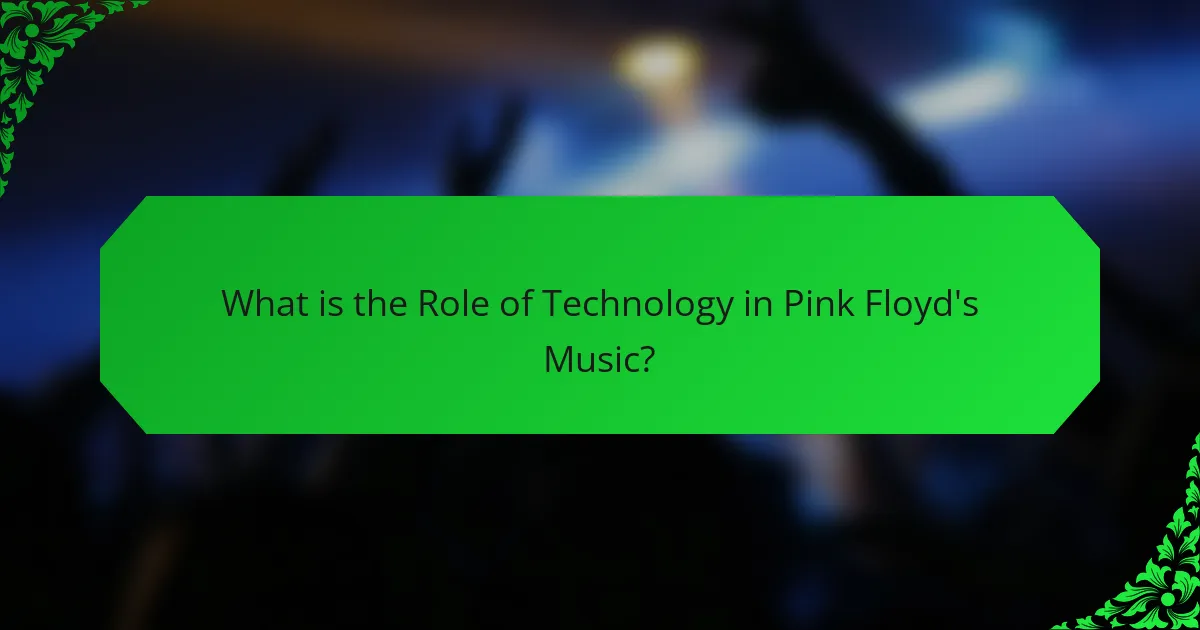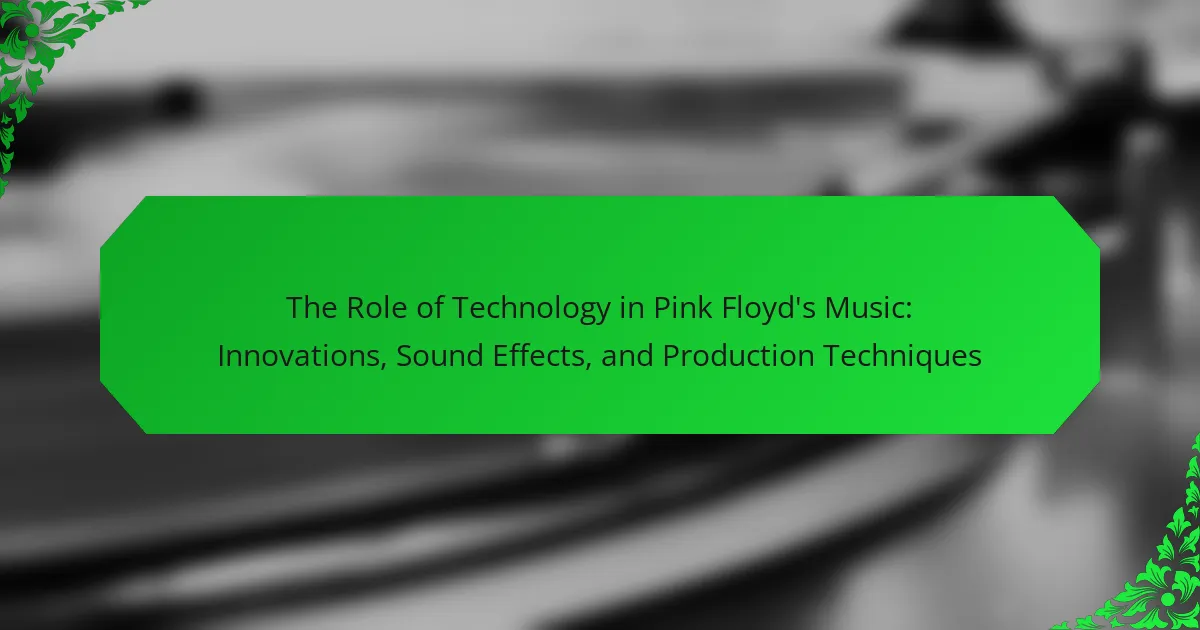The article explores the significant role of technology in Pink Floyd’s music, highlighting their innovative recording techniques, sound effects, and production methods. Key elements include the band’s pioneering use of multi-track recording, synthesizers, and advanced studio effects, which collectively enhanced their sonic landscape and contributed to the creation of immersive audio experiences. Notable works like “The Dark Side of the Moon” exemplify their groundbreaking sound design and studio experimentation. Additionally, collaboration with sound engineers, such as Alan Parsons, refined their production techniques, setting new standards in the music industry. This comprehensive overview covers how Pink Floyd’s technological innovations shaped their music and influenced broader trends in music production.

What is the Role of Technology in Pink Floyd’s Music?
Technology plays a crucial role in Pink Floyd’s music. The band utilized innovative recording techniques and sound effects to enhance their sound. They were pioneers in using multi-track recording, allowing for complex layering of instruments and vocals. Additionally, they incorporated synthesizers and electronic instruments, which expanded their sonic palette. Their album “The Dark Side of the Moon” famously employed advanced studio effects, including tape loops and sound manipulation. This album became a benchmark for studio production quality. Pink Floyd also integrated visual technology in their live performances, creating immersive experiences. Their use of technology not only shaped their music but also influenced the broader music industry.
How did technology influence Pink Floyd’s musical evolution?
Technology significantly influenced Pink Floyd’s musical evolution by enabling innovative soundscapes and production techniques. The band utilized synthesizers, such as the Moog and ARP, to create unique electronic sounds. Their use of multitrack recording allowed for complex arrangements and layering of instruments. In albums like “The Dark Side of the Moon,” they incorporated advanced studio effects, including tape loops and reverb, to enhance their sonic depth. The integration of sound effects, like spoken word and environmental sounds, added narrative elements to their music. Additionally, the use of technology in live performances, such as elaborate light shows and quadraphonic sound, transformed the concert experience. This technological embrace helped Pink Floyd establish a distinctive identity in progressive rock.
What technological advancements were pivotal in their early works?
The technological advancements pivotal in Pink Floyd’s early works include the use of multi-track recording and synthesizers. Multi-track recording allowed for complex layering of sounds, enhancing their sonic depth. This technique was crucial in albums like “The Piper at the Gates of Dawn.” Synthesizers, such as the EMS VCS3, introduced innovative electronic sounds. Their use was prominent in tracks like “Interstellar Overdrive.” Additionally, tape manipulation techniques expanded their creative possibilities. These advancements helped shape their unique sound and set them apart in the music industry.
How did Pink Floyd adapt to technological changes throughout their career?
Pink Floyd adapted to technological changes by embracing new recording techniques and equipment. They utilized advanced studio technology to create their signature sound. The band was among the first to use synthesizers extensively, as seen in “The Dark Side of the Moon.” They incorporated multi-track recording to layer sounds and enhance complexity. The use of quadraphonic sound in live performances showcased their commitment to innovation. Additionally, they experimented with tape effects and sound manipulation to craft unique auditory experiences. Their adaptation to technology allowed them to push musical boundaries and influence future generations.
What innovations in sound did Pink Floyd introduce?
Pink Floyd introduced several innovations in sound, including the use of synthesizers and advanced studio techniques. They were pioneers in the use of the Moog synthesizer, first featured in their album “The Dark Side of the Moon” in 1973. This album also showcased multi-track recording, allowing for complex layering of sounds.
Their experimentation with sound effects was groundbreaking. They utilized tape loops and found sounds, creating immersive audio experiences. The band’s use of surround sound during live performances set new standards for concert audio. Additionally, they were among the first to incorporate visual elements synchronized with music, enhancing the overall sensory experience.
These innovations significantly influenced the development of progressive rock and the music industry as a whole.
What specific instruments and equipment were used in their recordings?
Pink Floyd used a variety of instruments and equipment in their recordings. Key instruments included electric guitars, synthesizers, and drums. The Fender Stratocaster guitar was a signature instrument for David Gilmour. The band frequently employed the Moog synthesizer for its unique sound effects. They utilized the Mellotron for orchestral textures in their music. The use of tape machines allowed for innovative sound manipulation techniques. Additionally, they incorporated effects like reverb and delay to enhance their recordings. The combination of these instruments and equipment contributed to their distinctive sound.
How did the use of synthesizers change their sound?
The use of synthesizers significantly changed Pink Floyd’s sound. Synthesizers allowed for the creation of new textures and soundscapes. They introduced electronic elements that were previously unattainable with traditional instruments. This innovation contributed to the atmospheric quality of albums like “The Dark Side of the Moon.” The band’s use of synthesizers expanded their sonic palette, enabling complex layering of sounds. Tracks such as “On the Run” showcased the rhythmic and melodic capabilities of synthesizers. This shift marked a departure from conventional rock music, embracing a more experimental approach. Ultimately, synthesizers played a crucial role in defining Pink Floyd’s unique sound.

How did Sound Effects Shape Pink Floyd’s Music?
Sound effects significantly shaped Pink Floyd’s music by enhancing their sonic landscape. The band utilized innovative studio techniques to create immersive audio experiences. Their use of tape loops and reverb added depth to their sound. For instance, the iconic track “Echoes” features extensive sound manipulation. The band also employed synthesizers to produce unique textures. This experimentation contributed to the psychedelic nature of their work. Notably, their album “The Dark Side of the Moon” showcases groundbreaking sound design. The integration of sound effects helped convey themes and emotions throughout their music.
What role do sound effects play in Pink Floyd’s compositions?
Sound effects play a crucial role in Pink Floyd’s compositions. They enhance the emotional depth and atmosphere of their music. Pink Floyd often uses sound effects to create a sense of space and environment. For example, the use of recorded conversations and ambient noises adds realism to tracks. The band integrates sound effects seamlessly into their songs, making them integral to the overall experience. Albums like “The Dark Side of the Moon” feature innovative sound design that contributes to thematic storytelling. The use of technology in sound effects has allowed for unique auditory experiences. This experimentation has set Pink Floyd apart in the progressive rock genre.
Which iconic sound effects are associated with their most famous tracks?
Pink Floyd’s music is characterized by several iconic sound effects. The “heartbeat” sound in “Speak to Me” creates an immersive experience. The use of synthesizers in “On the Run” produces a distinctive electronic sound. “Time” features clock ticking and alarm sounds, enhancing its thematic depth. The “coughing” sound in “The Great Gig in the Sky” adds emotional weight. The “ping” sound in “Echoes” creates an ethereal atmosphere. These effects highlight the band’s innovative use of technology in music production.
How do sound effects contribute to the storytelling in their albums?
Sound effects enhance storytelling in albums by creating immersive environments. They establish mood and atmosphere, drawing listeners into the narrative. For example, the use of echo and reverb in “The Dark Side of the Moon” evokes feelings of introspection and anxiety. Sound effects also provide context, helping to illustrate themes and emotions. In “Animals,” ambient sounds reflect the industrial setting and social commentary. Furthermore, sound effects can signify transitions between sections, guiding the listener through the story. Overall, they serve as a crucial tool in conveying complex ideas and emotions within the music.
What techniques did Pink Floyd use in music production?
Pink Floyd employed various innovative techniques in music production. They utilized multi-track recording to layer sounds and create complex compositions. The band often incorporated synthesizers to generate unique soundscapes. They also made extensive use of tape manipulation, including reverse playback and tape loops. Sound effects played a crucial role, with elements like spoken word and environmental sounds enhancing their music. The band experimented with stereo panning to create immersive listening experiences. Additionally, they used innovative studio techniques, such as the EMS Synthi AKS and the Mellotron, to expand their sonic palette. Their approach to production significantly influenced the development of progressive rock music.
What are the key production techniques that defined their sound?
Pink Floyd’s sound was defined by several key production techniques. One significant technique was the use of multi-track recording. This allowed them to layer various instruments and vocals, creating a rich soundscape. They also employed tape manipulation, which included reversing tapes and altering playback speeds. This technique added unique textures to their music.
Another important method was the use of synthesizers, particularly the EMS Synthi A and ARP 2600. These instruments contributed to the band’s innovative sound. Additionally, they utilized sound effects extensively, incorporating spoken word samples and environmental sounds. This approach enhanced the atmospheric quality of their albums.
Finally, the band often collaborated with engineers like Alan Parsons. His expertise in sound engineering helped refine their production techniques, resulting in a polished final product. These production techniques collectively contributed to Pink Floyd’s distinctive musical identity.
How did multi-tracking and layering enhance their music?
Multi-tracking and layering significantly enhanced Pink Floyd’s music by allowing complex soundscapes and rich textures. This technique enabled the band to combine multiple recordings of instruments and vocals seamlessly. Each track could be recorded separately, providing greater control over the sound. This resulted in an intricate mix that created depth and dimension in their songs. For example, in “The Dark Side of the Moon,” multi-tracking allowed for the layering of harmonies and sound effects that contributed to the album’s immersive experience. The use of layering also facilitated the blending of different musical styles and influences. This innovation in production techniques set Pink Floyd apart in the music industry and contributed to their unique sound.

What are the key production techniques used by Pink Floyd?
Pink Floyd utilized several key production techniques in their music. One significant technique was the use of multi-tracking. This allowed them to layer multiple instrumental and vocal tracks for a richer sound. They also employed innovative sound effects, including tape loops and reverse recordings. These techniques contributed to their unique sonic landscape.
Another important technique was the use of synthesizers. Instruments like the Moog and ARP were integral to their sound. Additionally, they utilized spatial audio techniques, creating immersive listening experiences. Their album “The Dark Side of the Moon” exemplifies these production methods, showcasing complex arrangements and innovative studio techniques.
The band frequently collaborated with sound engineers, such as Alan Parsons. His expertise helped refine their production techniques. Pink Floyd’s approach to sound design and studio experimentation set new standards in music production.
How did studio experimentation influence their music?
Studio experimentation significantly influenced Pink Floyd’s music by allowing them to explore new soundscapes and production techniques. The band utilized innovative recording methods, such as multi-track recording and tape manipulation. This experimentation led to the creation of complex sound layers in albums like “The Dark Side of the Moon.” They also incorporated unconventional instruments and sound effects, enhancing their sonic diversity. The use of synthesizers and electronic effects became prominent in their work. Their studio approach fostered a unique blend of rock, psychedelia, and progressive elements. This creative process ultimately shaped their distinctive musical identity and legacy.
What notable studio innovations did Pink Floyd implement?
Pink Floyd implemented several notable studio innovations that transformed music production. They pioneered the use of multi-track recording, allowing for complex layering of sounds. This technique enabled them to create intricate soundscapes in albums like “The Dark Side of the Moon.” They also utilized tape loops and sound effects, which added depth to their music. The band was among the first to use synthesizers extensively, particularly on “Wish You Were Here.” Additionally, they incorporated quadraphonic sound in their live performances and recordings, enhancing the auditory experience. Their innovative use of studio technology set new standards in the music industry.
How did live performances incorporate technology in unique ways?
Live performances incorporated technology in unique ways by utilizing advanced audio-visual equipment. Pink Floyd was known for their innovative use of surround sound systems. They employed elaborate light shows that synchronized with music, enhancing the overall experience. Additionally, they used projection screens to display visual art and animations during performances. This integration created an immersive environment for the audience. The use of synthesizers and electronic instruments also transformed their sound. Their pioneering approach set new standards for live concerts in the rock genre. These technological advancements contributed to a distinctive and memorable live performance experience.
What lessons can be learned from Pink Floyd’s use of technology in music?
Pink Floyd’s use of technology in music teaches the importance of innovation and experimentation. The band utilized advanced recording techniques and sound effects to create immersive musical experiences. For instance, they were pioneers in using synthesizers, such as the Moog, to expand their sound palette. Their album “The Dark Side of the Moon” incorporated multitrack recording and analog effects to enhance audio quality. Pink Floyd also employed visual technology in live performances, integrating elaborate light shows with their music. This approach demonstrated how technology can elevate artistic expression. The band’s success illustrates that embracing technological advancements can lead to groundbreaking artistic achievements.
How can modern artists apply Pink Floyd’s techniques in their work?
Modern artists can apply Pink Floyd’s techniques by incorporating innovative sound effects and production methods. They can use multi-layered soundscapes, similar to Pink Floyd’s albums like “The Dark Side of the Moon.” This approach creates immersive listening experiences. Additionally, artists can experiment with analog synthesizers and tape loops, which were crucial in Pink Floyd’s sound design.
Utilizing visual elements in live performances is another technique. Pink Floyd integrated elaborate light shows and projections, enhancing the overall experience. Modern artists can adopt similar visual storytelling methods to engage their audience.
Lastly, artists should explore thematic concepts in their work. Pink Floyd often addressed complex themes such as existentialism and human experience. By doing so, contemporary artists can create deeper connections with their audience, reminiscent of Pink Floyd’s impact on music and culture.
What are some best practices for integrating technology in music production?
Best practices for integrating technology in music production include using digital audio workstations (DAWs) for efficient workflow. DAWs like Ableton Live and Pro Tools allow for multi-track recording and editing. Utilizing MIDI technology enhances the ability to compose and arrange music easily. Employing plugins and virtual instruments expands sound design possibilities. Regularly updating software ensures access to the latest features and improvements. Collaborating with other musicians through cloud-based platforms facilitates remote production. Implementing high-quality audio interfaces improves sound capture and playback quality. Finally, backing up projects on external drives or cloud services prevents data loss. These practices enhance creativity and streamline the production process.
The main entity of this article is Pink Floyd, a renowned progressive rock band known for their innovative use of technology in music. The article explores the pivotal role of technology in shaping Pink Floyd’s sound, detailing their groundbreaking recording techniques, including multi-track recording and the use of synthesizers. It highlights key production methods, sound effects, and the integration of visual technology in their live performances, which collectively contributed to their unique musical identity and influence on the broader music industry. Additionally, the article discusses how these technological advancements not only enhanced their compositions but also set new standards in music production.
